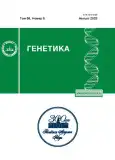The Use of the Genetic Resources of Tetraploid Wheat Triticum aethiopicum on the Developing of Purple-Grain Common Wheat with a High Content of Anthocyanins
- Authors: Fisenko А.V.1, Dragovich А.Y.1
-
Affiliations:
- Vavilov Institute of General Genetics, Russian Academy of Sciences
- Issue: Vol 59, No 8 (2023)
- Pages: 971-976
- Section: КРАТКИЕ СООБЩЕНИЯ
- URL: https://journal-vniispk.ru/0016-6758/article/view/134641
- DOI: https://doi.org/10.31857/S0016675823080064
- EDN: https://elibrary.ru/XTERRF
- ID: 134641
Cite item
Full Text
Abstract
The article considers the results on the developing of purple-grain common wheat and the study of its genetic diversity. Triticum aethiopicum Jakubz. 2n = 28 is the only source of genes for the purple grains color among the wheat species. The trait of purple grain is accompanied by an increase in the content of anthocyanins and micronutrients in the grain. To develop common wheat lines with purple grain, T. aethiopicum k-19068 was first hybridized with the Iranian landrace T. aestivum k-14333. The resulting hybrids were then crossed with the highly productive common wheat cultivar Liza. The developing lines F6 (2n = 42) characterize low diversity on multiple alleles of gliading-coding loci (H = 0.410). They were dominated by alleles inherited from the parent variety Liza. No gliadin alleles that could belong to T. aethiopicum have been identified. Comparison of groups of lines with purple and white grains made it possible to show that they do not significantly differ from each other in terms of yield and elements of its structure. As a result, we have not found a negative correlation between the high content of anthocyanins in grain and grain productivity. This allows us to hope for the possibility of developing high-yielding lines of common wheat with purple grain enriched with anthocyanins.
About the authors
А. V. Fisenko
Vavilov Institute of General Genetics, Russian Academy of Sciences
Author for correspondence.
Email: fisenko800@mail.ru
Russia, 119991, Moscow
А. Yu. Dragovich
Vavilov Institute of General Genetics, Russian Academy of Sciences
Author for correspondence.
Email: dragova@mail.ru
Russia, 119991, Moscow
References
- He J., Giusti M.M. Anthocyanins: Natural colorants with health-promoting properties // Ann. Rev. Food Sci. Technol. 2010. V. 10. № 1. P. 163–187. https://doi.org/10.1146/annurev.food.080708.100754
- Khoo H.E., Lim S.M., Azlan A. Evidence-based therapeutic effects of anthocyanins from foods // Pak. J. Nutr. 2019. V. 18. № 1. P. 1–11. https://doi.org/10.3923/pjn.2019.1.11
- Bagchi D., Sen C.K., Bagchi M. et al. Anti-angiogenic, antioxidant and anti-carcinogenic properties of a novel anthocyanin-rich berry extract formula // Biochem. (Mosc.) 2004. V. 69. № 1. P. 75–80. https://doi.org/10.1023/b:biry.0000016355.19999.93
- Cui J., Li X.Y. Progress on anti-tumor mechanisms of anthocyanins (Chinese) // Food Sci. 2014. V. 35. P. 310–315.
- Chen W.C., Liu H.M., Liu J.S. Progress in the research on anticarcinogenic activities of anthocyanins (Chinese) // Food Res. Dev. 2016. V. 37. P. 211–215.
- Guo Z., Zhang Z., Xu P. Analysis of nutrient composition of purple wheat // Cereal Res. Commun. 2012. V. 41. № 2. P. 293–303. https://doi.org/10.1556/CRC.2012.0037
- Kaur S., Pandey A.K., Kumari A., Garg M. Physiological and molecular response of colored wheat seedlings against phosphate deficiency is linked to accumulation of distinct anthocyanins // Plant Physiology and Biochemistry. 2022. V. 170. P. 338–349. https://doi.org/10.1016/j.plaphy.2021.12.017
- Gupta P.K., Balyan H.S., Sharma S., Kumar R. Biofortification and bioavailability of Zn, Fe and Se in wheat: Present status and future prospects // Theor. Appl. Genet. 2021. V. 134. № 1. P. 1–35. https://doi.org/10.1007/s00122-020-03709-7
- Тихвинский С.Ф., Доронин С.В. Антоциановые пигменты растений и их роль в адаптивной селекции сельскохозяйственных культур // Теор. и прикладная экология. 2007. № 3. С. 15–19.
- Гордеева Е.И. Генетическая регуляция фиолетовой окраски перикарпа зерна мягкой пшеницы (Triticum aestivum L.). Автореф. дис. канд. биол. наук. Новосибирск: ИЦиГ СО РАН, 2014. 16 с.
- Khlestkina E.K., Tereshchenko O.Yu., Salina E.A. Flavonoid biosynthesis genes in wheat and wheat-alien hybrids: Studies into gene regulation in plants with complex genomes // Radiobiology and Environmental Security. Dordrecht, Netherlands: Springer, 2012. P. 31–41.
- Jiang W., Liu T., Nan W. et al. Two transcription factors TaPpm1 and TaPpb1 co-regulate anthocyanin biosynthesis in purple pericarps of wheat // J. Exp. Bot. 2018. V. 69. № 10. P. 2555–2567. https://doi.org/10.1093/jxb/ery101
- Garg M., Chawla M., Chunduri V. et al. Transfer of grain colors to elite wheat cultivars and their characterization // J. Cereal Sci. 2016. V. 71. P. 138–144. https://doi.org/10.1016/j.jcs.2016.08.004
- Sharma S., Kapoor P., Kaur S. et al. Changing nutrition scenario: Colored wheat – a new perspective // Physiological, Molecular, and Genetic Perspectives of Wheat Improvement. Cham, Switzerland: Springer, 2021. (eBook). https://doi.org/10.1007/978-3-030-59577-7_4
- Martinek P., Jirsa O., Vaculova K. et al. Use of wheat gene resources with different grain colour in breeding // Conference. Tagungsband der 64. Jahrestagung der Vereinigung der Pflanzenzüchter und Saatgutkaufleute Österreichs. 25–26 November 2013. Raumberg-Gumpenstein. 2014. V. 1. P. 75–78.
- Metakovsky E.V., Novoselskaya A.Yu. Gliadin allele identification in common wheat. I. Methodological aspects // J. Genet. Breed. 1991. V. 45. P. 319–323.
- Metakovsky E.V. Gliadin allele identification on common wheat. II. Catalogue of gliadin allele in common wheat // J. Genet. Breed. 1991. V. 45. P. 325–344.
- Nei M. Molecular Population Genetics and Evolution. Amsterdam: Holland Press, 1975. 278 p.
- Central Statistical Agency of Ethiopia. Area and Production of Major Crops, Agricultural Sample Survey. Statistical Bulletin 586. Ethiopia: Addis Ababa, 2018.
- Мурашев В.В., Морозова З.А. Особенности морфогенеза пшеницы эфиопской T. aethiopicum Jacubz. (1974) в ЦРНЗ России; секция Dicoccoides; 2n = 28, геномы AuB // Научный альманах. Биологические науки. 2018. № 10-2(48). С. 163–173. https://doi.org/10.17117/na.2018.10.02.163
Supplementary files









